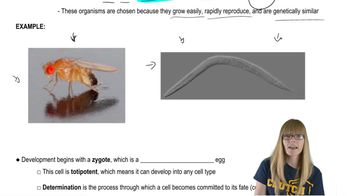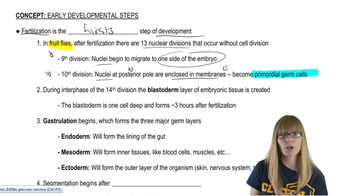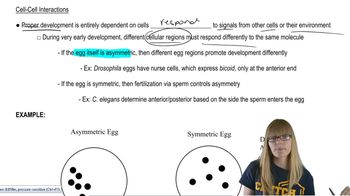Table of contents
- 1. Introduction to Genetics51m
- 2. Mendel's Laws of Inheritance3h 37m
- 3. Extensions to Mendelian Inheritance2h 41m
- 4. Genetic Mapping and Linkage2h 28m
- 5. Genetics of Bacteria and Viruses1h 21m
- 6. Chromosomal Variation1h 48m
- 7. DNA and Chromosome Structure56m
- 8. DNA Replication1h 10m
- 9. Mitosis and Meiosis1h 34m
- 10. Transcription1h 0m
- 11. Translation58m
- 12. Gene Regulation in Prokaryotes1h 19m
- 13. Gene Regulation in Eukaryotes44m
- 14. Genetic Control of Development44m
- 15. Genomes and Genomics1h 50m
- 16. Transposable Elements47m
- 17. Mutation, Repair, and Recombination1h 6m
- 18. Molecular Genetic Tools19m
- 19. Cancer Genetics29m
- 20. Quantitative Genetics1h 26m
- 21. Population Genetics50m
- 22. Evolutionary Genetics29m
14. Genetic Control of Development
Early Developmental Steps
Problem 10a
Textbook Question
Ablation of the anchor cell in wild-type C. elegans results in a vulva-less phenotype.
What about if the anchor cell is ablated in a let-23 gain-of-function mutant?
 Verified step by step guidance
Verified step by step guidance1
Understand the role of the anchor cell in C. elegans development. The anchor cell is crucial for signaling to the vulval precursor cells (VPCs) to induce vulval development.
Recognize that in wild-type C. elegans, ablation of the anchor cell leads to a vulva-less phenotype because the VPCs do not receive the necessary signals to differentiate into vulval tissue.
Identify the role of the let-23 gene. The let-23 gene encodes a receptor tyrosine kinase that is part of the signaling pathway activated by the anchor cell to induce vulval development.
Consider the effect of a gain-of-function mutation in let-23. A gain-of-function mutation means that the let-23 receptor is constitutively active, potentially bypassing the need for the anchor cell signal.
Predict the outcome: In a let-23 gain-of-function mutant, even if the anchor cell is ablated, the VPCs may still receive the signal to differentiate into vulval tissue due to the constitutive activity of the let-23 receptor.
Recommended similar problem, with video answer:
 Verified Solution
Verified SolutionThis video solution was recommended by our tutors as helpful for the problem above
Video duration:
4mPlay a video:
Was this helpful?
Key Concepts
Here are the essential concepts you must grasp in order to answer the question correctly.
Anchor Cell Function
In C. elegans, the anchor cell is crucial for vulval development as it secretes signals that induce the surrounding cells to form the vulva. Ablation of the anchor cell disrupts this signaling, leading to a vulva-less phenotype. Understanding the role of the anchor cell helps in grasping how cell signaling influences developmental processes.
Recommended video:
Guided course

Functional Genomics
let-23 Gene and Gain-of-Function Mutations
The let-23 gene encodes a receptor that is part of the epidermal growth factor (EGF) signaling pathway, which is essential for vulval development. A gain-of-function mutation in let-23 results in increased receptor activity, potentially altering the response of vulval precursor cells to signaling. This concept is vital for predicting how mutations can modify developmental outcomes.
Recommended video:
Guided course

Mutations and Phenotypes
Vulval Development in C. elegans
Vulval development in C. elegans is a well-studied model of cell signaling and fate determination. It involves a series of interactions between the anchor cell and vulval precursor cells, leading to the formation of the vulva. Understanding this process is key to analyzing how genetic mutations, like those in let-23, can affect developmental pathways and phenotypes.
Recommended video:
Guided course

Genetics of Development

 3:46m
3:46mWatch next
Master Drosophilia Development with a bite sized video explanation from Kylia Goodner
Start learningRelated Videos
Related Practice



